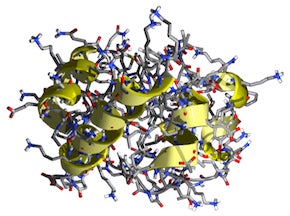Research in Chemical Biology at UC Riverside spans a broad area at the Chemistry-Biology interface. The central focus is to develop and apply chemical techniques and tools to study and manipulate biological systems. Research directions include combinatorial chemistry, laboratory engineering of proteins and nucleic acids, DNA damage and mutagenesis, optical and electrochemical biosensors, theoretical and experimental studies on biological dynamics and interactions, spectroscopic characterization of biosystems, and structural biology of biomolecules. Active collaborations exist within the Chemistry Department, as well as with research groups in other departments such as Biochemistry, Cell Biology and Neuroscience, Botany and Plant Science, Entomology, and Institute for Integrative Genome Biology. Please follow the links below to learn more about the individual Chemical Biology research groups at UCR.
Graduate students with a focus in Chemical Biology are expected to receive broad and highly interdisciplinary trainings in bioanalytical, bioorganic and biophysical chemistry.
Faculty Research Description:
Chia-en Chang
Molecular dynamics in chemical and biological systems: The Chang group primarily uses computational methods to investigate the chemistry of biological systems. The goal is to understand how molecules can bind and how molecular flexibility influences ligand binding, and use the knowledge to design drugs and interpret experiments. We have developed new methods to understand ligand binding kinetics.
Quan Jason Cheng
Research in the Cheng lab focuses on bio- and chemical sensors, functional biomaterials, and label-free surface plasmon resonance (SPR) techniques. We are particularly interested in measurement techniques involving supported lipid membranes, protein microarrays, surface-assisted MS methods, and novel platforms allowing orthogonal detection.
Emma Rova Danelius
The Danelius Lab uses the cryo-EM method MicroED and NMR to solve structures and conformations of dynamic ligands and their biological targets. One focus is on the discovery of new modalities beyond the traditional drug space, where conformational flexibility is important for activity and interactions. MicroED is an electron diffraction technique for the analysis of atomic structures from nanosized crystals. It offers new possibilities to determine challenging structures directly from powder formulations and can even be applied to compound mixtures.
Joseph Genereux
Cellular stresses can interfere with protein folding and trafficking, threatening cellular health. However, we have limited technology to characterize which proteins are impacted by threats to protein homeostasis. Our laboratory develops quantitative proteomics approaches to identify proteome-wide misfolding and mistrafficking in response to stress.
Richard Hooley
Synthetic Organic, Inorganic and Supramolecular chemistry. Our projects include: the synthesis of biomimetic supramolecular constructs capable of selective molecular recognition; synthesis of new water-soluble catalysts and host molecules; dynamic NMR studies of host:guest interactions; biosensors based on synthetic receptor molecules.
Ryan Julian
Protein homoeostasis is vital for proper cellular function and involves the turnover, or recycling of proteins. Although many proteins exist briefly, with half-lives of less than 48 hours, other proteins persist for years or longer. In some systems, such as the lens of the eye, proteins never turnover and must remain viable for the entire lifetime of an organism. Degradation of these long-lived proteins occurs in various ways including truncation, misfolding, and post-translational modification. Furthermore, degradation can be spontaneous or enzymatically driven. Many of these processes interact and influence each other, and, in the end, misbehavior of long-lived proteins eventually leads to malfunction and even cell death. We are interested in characterizing the relationships between the properties, structures, and functions of long-lived proteins utilizing mass spectrometry and other related techniques.
Samuel Mann
The Mann lab aims to merge (bio)inorganic chemical principles with protein design to construct new metalloproteins from scratch that help build structure-function relationships for natural metalloproteins and develop design principles for new-to-nature function. Our interests revolve around preparing and understanding reactive intermediates within our protein scaffolds and how to control reaction specificity at a metal center.
Leonard Mueller
Solid-state and solution-state NMR as a probe of structure and dynamics.
Michael Pirrung
Chemical biology, synthetic organic chemistry, nucleic acids, combinatorial chemistry; photochemistry.
Timothy Su
The Su lab is interested in understanding the factors that govern electronic transport in biomolecules at the single-molecule level as they relate to functional and pathological processes in biology. Projects in this area may involve small molecule chemical synthesis, single-molecule transport measurements, and a suite of chemical biology and biochemistry techniques.
Christopher Switzer
Design, synthesis and characterization of nucleic acid variants with new properties for molecular recognition, catalysis and replication.
Yinsheng Wang
Chemistry and biology of DNA damage, quantitative proteomics. A multi-pronged approach, encompassing synthetic chemistry, mass spectrometry-based bioanalytical chemistry, biochemistry and molecular biology, is employed to understand at the molecular level how structurely defined DNA lesions are repaired and how they compromise the flow of genetic information during DNA replication and transcription. Quantitative proteomics method is used for understanding the molecular mechanisms of action of anticancer drugs and environmental toxicants.
Yue Wu
The overarching goal of our research is to advance high-throughput bioanalytical chemistry through the development of innovative optical and molecular barcoding technologies, integrating photonic materials, imaging, and omics approaches.
Linlin Zhao
The Zhao lab is dedicated to understanding the intricate world of mitochondrial DNA (mtDNA) metabolism and its associated signaling pathways using a combination of chemical and cellular tools. A key focus of their research involves the development of novel chemical probes. These innovative tools are designed to specifically target and investigate nucleic acid modifications found within both the nucleus and mitochondria. Their goal is to study and manipulate these crucial biological molecules, shedding light on their fundamental roles in health and disease.

